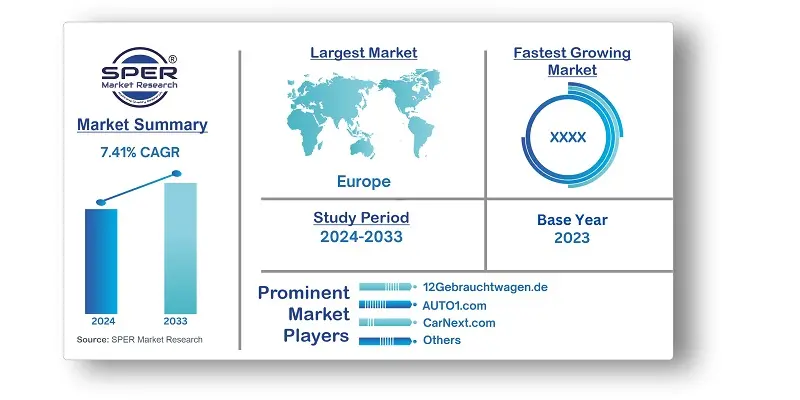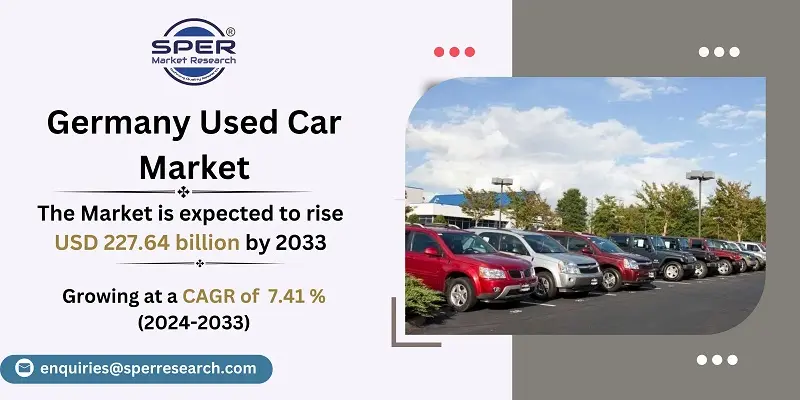
Germany Used Car Market Growth, Size, Trends, Demand, Revenue, Share and Future Outlook
Germany Used Car Market Size- By Vendor Type, By Fuel Type, By Body Type, Sales Channel- Regional Outlook, Competitive Strategies and Segment Forecast to 2033
| Published: Mar-2024 | Report ID: AMIN2490 | Pages: 1 - 107 | Formats*: |
| Category : Automotive & Transportation | |||
- Driverama Germany GmbH launched a car purchase service in Germany one year prior to starting an online used car sales business in February 2022. Driverama has launched a new tool that lets consumers compare over 1,000 completely inspected automobiles with an average age of four years, including popular models, brands, prices, and financing choices. Every car has a complete service history, an ownership report, and a thorough cleaning.


| Report Metric | Details |
| Market size available for years | 2020-2033 |
| Base year considered | 2023 |
| Forecast period | 2024-2033 |
| Segments covered | By Vendor Type, By Fuel Type, By Body Type, Sales Channel |
| Regions covered | Eastern, Western, Southern, Northern |
| Companies Covered | 12Gebrauchtwagen.de, AUTO1.com GmbH, AutoScout24 GmbH, CarNext.com, Cazoo Ltd., Cinch Cars Limited, Driverama Germany GmbH, mobile.de, OOYYO Corporation, pkw.de Autoborse GmbH, SAAM, TASA LogÃstica, Others. |
- Budget-Conscious Consumers
- College Students
- Families on a Budget
- First-Time Car Buyers
- Small Business Owners
- Temporary Residents or Expats
- Others
| By Vendor: |
|
| By Fuel Type: |
|
| By Body Type: |
|
| By Sales Channel: |
|
- Germany Used Car Market Size (FY’2024-FY’2033)
- Overview of Germany Used Car Market
- Segmentation of Germany Used Car Market By Vendor (Organized, Unorganized)
- Segmentation of Germany Used Car Market By Fuel Type (Petrol, Diesel, Electric, Others)
- Segmentation of Germany Used Car Market By Body Type (Hatchback, Sedan, SUVs and MPVs)
- Segmentation of Germany Used Car Market By Sales Channel (Online, Offline)
- Expansion Analysis of Germany Used Car Market
- Problems and Obstacles in Germany Used Car Market
- Competitive Landscape in the Germany Used Car Market
- Impact of COVID-19 and Demonetization on Germany Used Car Market
- Details on Current Investment in Germany Used Car Market
- Competitive Analysis of Germany Used Car Market
- Prominent Players in the Germany Used Car Market
- SWOT Analysis of Germany Used Car Market
- Germany Used Car Market Future Outlook and Projections (FY’2024-FY’2033)
- Recommendations from Analyst
1.1. Scope of the report1.2. Market segment analysis
2.1. Research data source2.1.1. Secondary Data2.1.2. Primary Data2.1.3. SPER’s internal database2.1.4. Premium insight from KOL’s2.2. Market size estimation2.2.1. Top-down and Bottom-up approach
2.3. Data triangulation
4.1. Driver, Restraint, Opportunity and Challenges analysis4.1.1. Drivers4.1.2. Restraints4.1.3. Opportunities4.1.4. Challenges
4.2. COVID-19 Impacts of the Germany Used Car Market
5.1. SWOT Analysis5.1.1. Strengths5.1.2. Weaknesses5.1.3. Opportunities5.1.4. Threats5.2. PESTEL Analysis5.2.1. Political Landscape5.2.2. Economic Landscape5.2.3. Social Landscape5.2.4. Technological Landscape5.2.5. Environmental Landscape5.2.6. Legal Landscape5.3. PORTER’s Five Forces5.3.1. Bargaining power of suppliers5.3.2. Bargaining power of buyers5.3.3. Threat of Substitute5.3.4. Threat of new entrant5.3.5. Competitive rivalry5.4. Heat Map Analysis
6.1. Germany Used Car Market Manufacturing Base Distribution, Sales Area, Product Type6.2. Mergers & Acquisitions, Partnerships, Product Launch, and Collaboration in Germany Used Car Market
7.1. Germany Used Car Market Value Share and Forecast, By Vendor, 2024-20337.2. Organized7.3. Unorganized
8.1. Germany Used Car Market Value Share and Forecast, By Fuel Type, 2024-20338.2. Petrol8.3. Diesel8.4. Electric8.5. Others
9.1. Germany Used Car Market Value Share and Forecast, By Body Type, 2024-20339.2. Hatchback9.3. Sedan9.4. SUVs and MPVs
10.1. Germany Used Car Market Value Share and Forecast, By Sales Channel, 2024-203310.2. Online10.3. Offline
11.1. Germany Used Car Market Size and Market Share
12.1. Germany Used Car Market Size and Market Share By Vendor (2020-2026)12.2. Germany Used Car Market Size and Market Share By Vendor (2027-2033)
13.1. Germany Used Car Market Size and Market Share By Body Type (2020-2026)13.2. Germany Used Car Market Size and Market Share By Body Type (2027-2033)
14.1. Germany Used Car Market Size and Market Share By Body Type (2020-2026)14.2. Germany Used Car Market Size and Market Share By Body Type (2027-2033)
15.1. Germany Used Car Market Size and Market Share By Sales Channel (2020-2026)15.2. Germany Used Car Market Size and Market Share By Sales Channel (2027-2033)
16.1. Germany Used Car Market Size and Market Share By Region (2020-2026)16.2. Germany Used Car Market Size and Market Share By Region (2027-2033)16.3. Eastern Region16.4. Northern Region16.5. Southern Region16.6. Western Region
17.1. 12Gebrauchtwagen.de17.1.1. Company details17.1.2. Financial outlook17.1.3. Product summary17.1.4. Recent developments17.2. AUTO1.com GmbH17.2.1. Company details17.2.2. Financial outlook17.2.3. Product summary17.2.4. Recent developments17.3. AutoScout24 GmbH17.3.1. Company details17.3.2. Financial outlook17.3.3. Product summary17.3.4. Recent developments17.4. CarNext.com17.4.1. Company details17.4.2. Financial outlook17.4.3. Product summary17.4.4. Recent developments17.5. Cazoo Ltd.17.5.1. Company details17.5.2. Financial outlook17.5.3. Product summary17.5.4. Recent developments17.6. Cinch Cars Limited17.6.1. Company details17.6.2. Financial outlook17.6.3. Product summary17.6.4. Recent developments17.7. Driverama Germany GmbH17.7.1. Company details17.7.2. Financial outlook17.7.3. Product summary17.7.4. Recent developments17.8. mobile.de17.8.1. Company details17.8.2. Financial outlook17.8.3. Product summary17.8.4. Recent developments17.9. OOYYO Corporation17.9.1. Company details17.9.2. Financial outlook17.9.3. Product summary17.9.4. Recent developments17.10. pkw.de Autoborse GmbH17.10.1. Company details17.10.2. Financial outlook17.10.3. Product summary17.10.4. Recent developments17.11. SAAM17.11.1. Company details17.11.2. Financial outlook17.11.3. Product summary17.11.4. Recent developments17.12. TASA LogÃstica17.12.1. Company details17.12.2. Financial outlook17.12.3. Product summary17.12.4. Recent developments17.13. Others
SPER Market Research’s methodology uses great emphasis on primary research to ensure that the market intelligence insights are up to date, reliable and accurate. Primary interviews are done with players involved in each phase of a supply chain to analyze the market forecasting. The secondary research method is used to help you fully understand how the future markets and the spending patterns look likes.
The report is based on in-depth qualitative and quantitative analysis of the Product Market. The quantitative analysis involves the application of various projection and sampling techniques. The qualitative analysis involves primary interviews, surveys, and vendor briefings. The data gathered as a result of these processes are validated through experts opinion. Our research methodology entails an ideal mixture of primary and secondary initiatives.



Frequently Asked Questions About This Report
PLACE AN ORDER
Year End Discount
Sample Report
Pre-Purchase Inquiry
NEED CUSTOMIZATION?
Request CustomizationCALL OR EMAIL US
100% Secure Payment






Related Reports
Our Global Clients
Our data-driven insights have influenced the strategy of 200+ reputed companies across the globe.




















